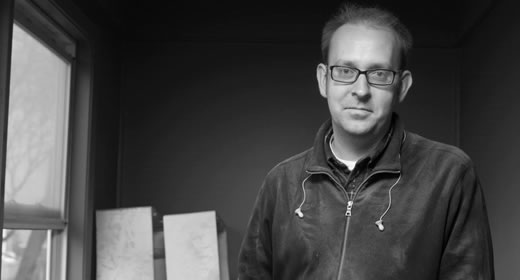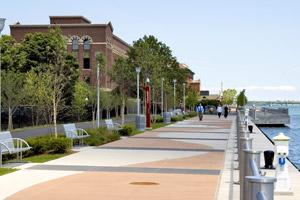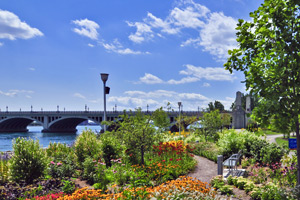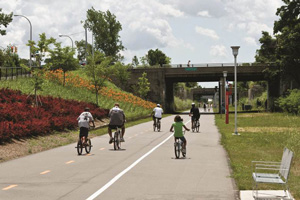
A couple years ago, Mark Wallace (MPP ’04) built two electric guitars. A long-time musician, he had recently taken up woodworking and thought he might give guitar-making a try.
He built two, he says, because he was afraid that one might not work out. And he was right: “One was a disaster,” he says. “But the other one turned out pretty great.”
It’s moderately impressive for a hobbyist to be able to make his own guitar; however what’s really striking is the rarity of the wood that Wallace used. Many premium guitars boast of exotic hardwoods. Wallace’s guitar used a softer wood—pine—but a rare type of pine found only in a single place: Detroit. His guitar is made of pine reclaimed from demolished Detroit houses; pine from forests that once stretched the length of Michigan.
 |
The story of Wallace’s guitars is emblematic of his work in Detroit. He is a man with a keen ability to see the potential in people, places, and things, along with the drive and knowledge to help attain that potential.
When a friend of a friend first showed Wallace the lumber they were saving from demolished homes, Wallace immediately thought of making a guitar and, on the spot, used his smartphone to find the CAD plans for his guitar design. Not long after his initial guitar-making gambit, he founded Wallace Detroit Guitars and they made over fifty such guitars in their first year of business—all of which have been snatched up by musicians from Detroit, and across the nation.
Wallace’s ability to find new ways to improve and enjoy old Detroit isn’t just his hobby, though. It’s also his job. As president and CEO of the Detroit RiverFront Conservancy (DRFC), Wallace is responsible for the stewardship and improvement of five-and-a-half miles of land along the Detroit River.
Fifteen years ago, if you tried to walk westward along the river from Belle Isle you would have had a difficult time. You would’ve run into fenced-off private property, deteriorated public property, and a few risks to your personal safety like industrial waste, scrap metal, and broken glass.
 |
Established in 2003, the Conservancy was formed to develop public and private partnerships that would create a riverfront area of which the city could be proud.
While Wallace began his role as executive director of the Conservancy only last summer, he came with a decade of riverfront restoration experience through his work at Hines Interests LP, a real estate development, investment, and management firm. At Hines, Wallace worked on the renovation of the riverfront Renaissance Center and the three-and-a-half-mile stretch known as East Riverfront, which extends from the Joe Louis Arena to Gabriel Richard Park, just east of Belle Isle.
Today, that same stretch (now under the management of the Conservancy) connects some of the city’s historic parks and public spaces and offers new amenities like a wide river walk, wetlands and butterfly gardens, public fishing spots, bicycle rentals, a playground with water features for hot summer days, fountains, a carousel, and delightful views. The Conservancy estimates three million visitors each year.
While Wallace lives in Corktown and works from an office in a skyscraper overlooking the river, it’s clear that his thoughts are with all kinds of people throughout the city and he wants the riverfront to be accessible and appealing to all.
 |
“We [the Conservancy] were one of the first organizations in the state to focus on community engagement as a precedent event for construction and new development,” he says. “Today, that’s a very common approach. It was very uncommon at the time we did it.”
“The community engagement ranged from a meeting with five people in the basement of a church on the east side to a meeting with a thousand people at the United Auto Workers Center. It covered a really broad spectrum and our basic commitment is that if someone wants us to talk with them or listen to them, we’ll show up.”
“We asked questions like ‘what would you like to see? How would you like it to function? What do you want to do on the riverfront? How do you want to get there?’ As a result of these engagements and our work, the riverfront has become a place where everyone has a sense of ownership and belonging.”
By Bob Brustman for State & Hill, the magazine of the Gerald R. Ford School of Public Policy
Below is a formatted version of this article from State & Hill, the magazine of the Ford School. View the entire Fall 2015 State & Hill here.